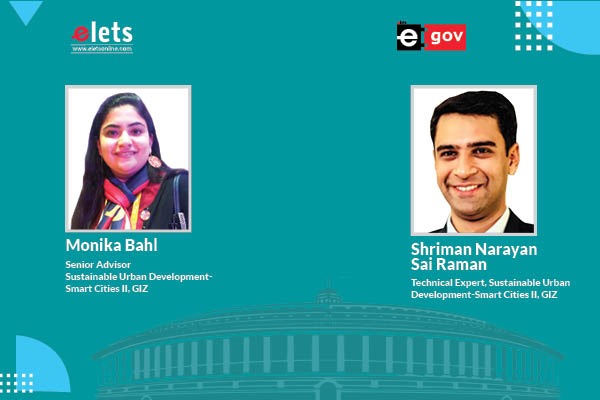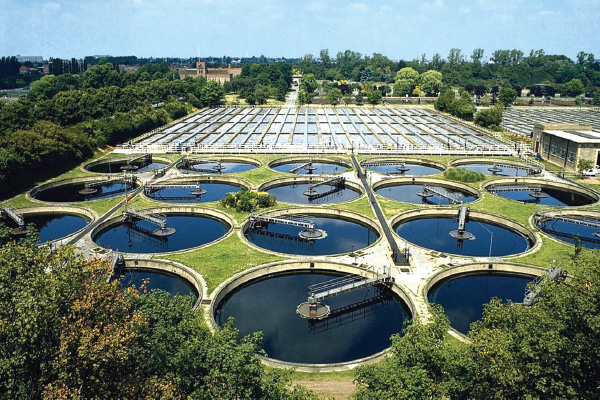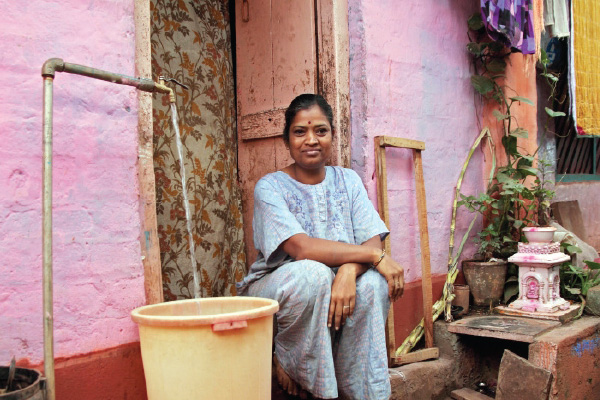
The Sustainable Development Goal (SDG) 6.1 aims to ‘achieve universal and equitable access to safe and affordable drinking water for all’ by 2030. It can be seen as a stimulus for governments to take necessary actions to improve the equity of water distribution across the country, write Monika Bahl, Senior Advisor, Sustainable Urban Development-Smart Cities II, GIZ and Shriman Narayan Sai Raman, Technical Expert, Sustainable Urban Development – Smart Cities II, GIZ.
In India, the Atal Mission For Rejuvenation And Urban Transformation (AMRUT 2.0), a national Mission of the Government of India, aims to provide water security through a 24×7 water supply with a drink from the tap facility in 500 AMRUT cities. Water security has been defined as “the reliable availability of an acceptable quantity and quality of water for health, livelihoods and production, coupled with an acceptable level of water-related risks”.¹ In this context, this article identifies the challenges and explores opportunities to overcome such challenges within the context of AMRUT cities in India.

Recycling wastewater post-effective treatment could improve water availability in the country
Source: https://planet.outlookindia.com/public/uploads/article/flood-wastewater-recycling-1280×720.jpg
AMRUT 2.0

AMRUT 2.0 is a step towards AatmaNirbhar Bharat to make the cities ‘water secure’ and provide functional water tap connections to all households to achieve a 24×7 water supply. This will be achieved through a circular economy of water by effective water source conservation, rejuvenation of water bodies and wells, recycling/ reuse of treated water, and rainwater harvesting by involving the community at large. AMRUT 2.0 focuses on empowering States/ Union Territories (UTs) and cities for efficient implementation of projects in the spirit of cooperative and competitive federalism by providing flexibility to the States/ UTs to formulate, plan and implement the projects.
AMRUT 2.0 has a reform agenda for achieving financial sustainability and water security of ULBs by meeting 20 per cent of water demand through recycled water, reducing non-revenue water to less than 20 per cent, and rejuvenating water bodies. It is thus the policy of the Government of India to work towards universal 24×7 supplies. This requirement is also recognised in the UN Handbook on water and sanitation as a human right (De Albuquerque 2014) because unsustainable systems result in a loss of supply and thus a loss of a human right.

Translating the vision of AMRUT 2.0 into reality and meeting SDG 6.1 requires serious efforts to be channelised into addressing existing bottlenecks from the policy perspective. Operational efficiencies can only emerge within the existing institutional frameworks with decentralised functions and ringfenced approaches to resources. The below non-exhaustive list can help address such challenges and help achieve sustainable and efficient water supply systems that can cater to 24×7 water supply.
Sustained Political Commitment
The water assets in the capital- intensive water sector outlive an electoral democracy that encourages short-term decision-making. To ensure the sustainability of the interventions made in the water sector, emphasis has to be laid on managing the water assets with a much longer-term in view, beyond 2030 to achieve the goal of universal access to safely managed service levels, as highlighted in AMRUT 2.0. This requires coordination and collaboration through integrated planning as well as all political factions agreeing to continue the set direction and policies.

Source: Government/ GIZ reference/pic
Availability of Reliable Data
The reliability of data on supply systems, on water abstracted and treated, and on population served becomes a crucial indicator for achieving the Sustainable Development Goals. Reliable data also determine what has to be done, how it will be financed, human resource requirements and developments, and realistic improvement delivery planning. Achieving reliable baseline data and putting in place effective management and operational database systems require planning and investment. Included in the data system would be responsibilities for reporting to the JMP on progress and the processes for collecting, analysing and verifying the performance data.
Integrated Investment Planning
If planning is annual as part of annual budgeting with independent decisions on large infrastructure projects, the short vision does not allow for integrated investment decisions and the focus is diverted towards obtaining budget approvals and associated government subsidies. In contexts where countries focus on detailed design plans for infrastructure for 20 years or more in the form of master plans, they are expensive, not water- consumer service driven, and do not provide flexibility to address unpredictability; nor do they allow for the benefits of future improved technology.
Therefore, the requirement is for long-term strategic plans and short-term delivery plans. With SDG 6.1, a strategic plan leading to achieving that goal in 2030 would be appropriate where it describes the ‘what’ and the ‘when’ expressed in terms of service delivery standards. Reflecting water service reform laws stated government policies and the responsibilities of the various stakeholders, and an indication of investment and funding. On the other hand, the delivery plans focus on “delivery” intended to improve the situation technically and operationally over a fixed timeline, with human and financial resources ringfenced for monitoring and reporting.
Spatial Planning to Secure Water Resources
Water storage becomes even more important with apparent greater uncertainty for rainfall due to climate change. In addition to increased lake and reservoir capacity, the storage capacity of aquifers requires greater attention. Over-abstraction causes water quality problems and lower groundwater levels suggest that there is much unused underground storage capacity. Controlled runoff through creating ‘contour bunding’ has benefits of groundwater recharge, reduced soil erosion, improved irrigation and improved water quality. This can be done on a large scale. It costs very little in areas where people are pleased to provide labour. Rainwater harvesting from roofs and other hard surfaces can add to the overall storage capacity. Storage should be considered in an integrated way.

Source: https://tappwater.co/en/wp-content/uploads/sites/13/2019/04/tap-water-in-india.jpg
Water Distribution & Leakage Management
The importance of leakage management is most evident in achieving continuous supply. In intermittent supplies, the safety of drinking water is at great risk through the frequent pressurisation and depressurisation of the pipes that deteriorates the system and leads to increased leakage at joints. The resulting reduction in pressure is offset by increased pumping pressure, leading to higher leakage and a cycle of decline. As a result, consumers lose confidence which impacts payments.
There is also a lack of incentive to lay or fix water distribution infrastructure instead of building water treatment plants that are politically more appealing. Water costs are dominated by water distribution with infrastructure construction and life costs around 65 per cent of total supply costs. The required investment in piped distribution systems will be the dominant cost of achieving SDG 6.1. The neglect of distribution systems has impacted the creditworthiness of utilities for effective maintenance to be carried out which has led to high levels of leakage. Non-revenue water (including commercial and physical losses) typically ranges between 15–30 per cent. In India, leakage is not measured primarily because either supply meters are dysfunctional or distribution zone meters and consumer meters are absent where water charges are levied as a fixed sum.
Distribution Networks
What are the challenges in moving from intermittent to a continuous water supply? First, it requires a significant proportion of available investment money, phased over time. Second, the system deteriorates with new leaks as existing leaks are fixed. The solution is to form distribution metering areas (DMAs) which are small enough for an affordable rapid rehabilitation and can be maintained 24×7 as the rehabilitation progresses from one DMA to another until the whole urban area is completed. This has been attempted in the cities of Nagpur, Coimbatore, Hubli-Dharwad, Belgaum, and Gulbarga, where a part of the city was metered and networked to achieve continuous water supply before undertaking similar interventions in other parts of the city. In December 2021, the Ministry of Housing and Urban Affairs (MoHUA) with support from Deutsche Gesellschaft für Internationale Zusammenarbeit (GIZ) GmbH organised a Technical Conference and Exhibition to inspire cities to make efforts toward 24X7 water supply systems and adopt the principles of the circular economy for the water sector².
In India, over 20 cities including Puri have recently made attempts to move towards continuous systems either fully or partially which were exhibited during the event. However, it was clear that it is a long journey to ensure Indian cities moved toward this system. As part of AMRUT 2.0, cities need to adopt integrated water resource management with water conservation through recycling of used water, control of NRW and rejuvenation of water bodies and also to take up 24×7 water supply projects at least in one ward/DMA. This requires a good network analysis of the distribution system which often does not exist, moreover, the data for building models does not exist. Investment of time and resources to make data available to build the models will be essential. This will help identify leakage and make the system more efficient.
In conclusion, achieving continuous water supply requires the recognition of the ‘governance’ problem in addition to an ‘engineering’ problem that requires various stakeholders at different levels to coordinate and collaborate with a ringfenced approach to human, financial and institutional resources. Such an integrated approach will help achieve the objectives of AMRUT 2.0 and SDG 6.1 and achieve welfare goals such as eliminating hunger, reducing inequality, and ensuring good health and well-being.
1. Water Security & Nexus, United Nations University https://unu.edu/projects/water-security-nexus.html#outline
2. https://pib.gov.in/PressReleasePage.aspx?PRID=1783919
Be a part of Elets Collaborative Initiatives. Join Us for Upcoming Events and explore business opportunities. Like us on Facebook , connect with us on LinkedIn and follow us on Twitter, Instagram.











